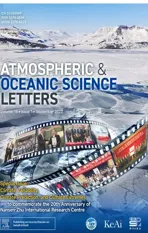Contribution of external forcing to summer precipitation trends over the Qinghai—Tibet Plateau and Southwest China
2023-10-11YuyingXingToWngHongnXuHuijunWng
Yuying Xing,To Wng,b,∗,Hongn Xu,Huijun Wng,b
a Collaborative Innovation Center on Forecast and Evaluation of Meteorological Disasters(CIC‑FEMD),Nanjing University of Information Science and Technology,Nanjing,Chinab Climate Change Research Center and Nansen-Zhu International Research Centre,Institute of Atmospheric Physics,Chinese Academy of Sciences,Beijing,China
Keywords: Summer precipitation Qinghai—Tibet plateau Southwest China CMIP6 External forcing
ABSTRACT In the past 60 years,the global climate has undergone both rapid warming and a brief warming hiatus,while regional precipitation patterns in China have also experienced diverse and complex changes.Specifically,the factors behind the opposing trends in summer precipitation between two adjacent regions—Southwest China and the Qinghai—Tibet Plateau—are particularly intricate.After evaluating the historical runs from CMIP6 models,the authors assessed the contributions of various external forcing factors that simulated the summer precipitation trends observed over the Qinghai—Tibet Plateau and Southwest China from 1961 to 2014.The findings show that,compared to other forcing factors,greenhouse gases had a significant impact on the increase in summer precipitation over the Qinghai—Tibet Plateau,while aerosols played an important role in the decrease in summer precipitation in Southwest China.
1.Introduction
Against the current background of global warming,China has experienced significant changes in precipitation,with marked regional variations (e.g.,Chou and Lan,2012;Tan et al.,2014;Miao et al.,2016;Xu et al.,2017;Zhou and Wang,2017).Over the past five decades,annual precipitation in China has exhibited a slight upward trend,with the Qinghai—Tibet Plateau,Northwest China,and South China experiencing an increase,but Northeast China,North China,and Southwest China a decrease (Chen et al.,2019;Zhai et al.,2005;Liu,2005;Zhang et al.,2009;Zheng et al.,2022).Moreover,precipitation in China exhibits significant interdecadal variation.Summer rainfall has decreased over the lower reaches of the Yellow River and the Huaihe River since the late 1970s,but increased over the lower reaches of the Yangtze River,linked to the weakening East Asian monsoon circulation(Wang,2001).At the same time,a decadal decline in the South Asian high also contributed to the weakening of the Asian monsoon circulation (Zhang et al.,2022a).Numerous researchers have explained the mechanisms behind the decadal transition of precipitation in China,based on factors such as the Arctic Oscillation,El Niño—Southern Oscillation,snow cover on the Qinghai—Tibet Plateau,and Pacific Decadal Oscillation(Gu et al.,2009;Wang et al.,2016,2017,2018;Li et al.,2018;Zhu,2022).
Generally,most of the CMIP5 and CMIP6 models can effectively capture the main spatial distribution features of rainfall and temperature,as documented in previous studies (Xu and Xu,2012;Eyring et al.,2016;Xin et al.,2020;Xu et al.,2021;Zhang et al.,2022b;Li et al.,2023).These models have also been employed in precipitation attribution analyses in China (Lu et al.,2018;Pei et al.,2018;Paik et al.,2020).Past research has suggested that human activities contribute to more intense extreme precipitation events (Wang et al.,2013;Dong et al.,2021;Liu et al.,2021),while anthropogenic aerosols play a key role in the decrease in global land monsoon precipitation (Zhai et al.,2018). Additionally,strong external greenhouse gas forcing is associated with an increase in precipitation over China (Zhao et al.,2015;Li et al.,2017).Zhou et al.(2018) focused on separating the relative contributions of natural and anthropogenic forcings in extreme precipitation events in China and highlighted the attribution uncertainty arising from different types of climate simulations.Based on CMIP5 ensemble simulation results,Ma et al.(2017) provided evidence that anthropogenic forcing had a detectable and attributable impact on the distribution of daily precipitation amounts over eastern China during the second half of the 20th century.The detectable influences of greenhouse gas and anthropogenic forcing on the observed shift in the distribution of daily precipitation towards intense precipitation are significant (Ma et al.,2017;Liu et al.,2015).However,more attention has been devoted to the eastern monsoon region in China,while comparative research on Southwest China and the Qinghai—Tibet Plateau is still limited.
Therefore,the aim of this study was to investigate the trends in summer precipitation over the Qinghai—Tibet Plateau and Southwest China.Using the latest CMIP6 models,this study examined the respective impacts of anthropogenic and natural forcings on summer precipitation over the Qinghai—Tibet Plateau and Southwest China.Section 2 describes the data and methods used in the study,while Section 3 presents the results.Finally,conclusions are presented in Section 4.
2.Data and methods
In this study,we utilized experiments from CMIP6—specifically,the historical,historical aerosol,historical greenhouse gas,and historical natural experiments conducted by nine models over the period 1961—2014 (see Table 1 for the model details).The historical simulation,referred to simply as “historical”,is forced by both natural and anthropogenic factors.Meanwhile,the historical aerosol simulation (hist-aer)and greenhouse gas simulation (hist-GHG) are similar to the historical simulation,except they are only forced by changes in anthropogenic aerosol and well-mixed greenhouse gasses,respectively.The historical natural simulation (hist-nat) is forced by external natural factors,such as volcanic aerosols and solar variability.Further information can be found in Table 2.
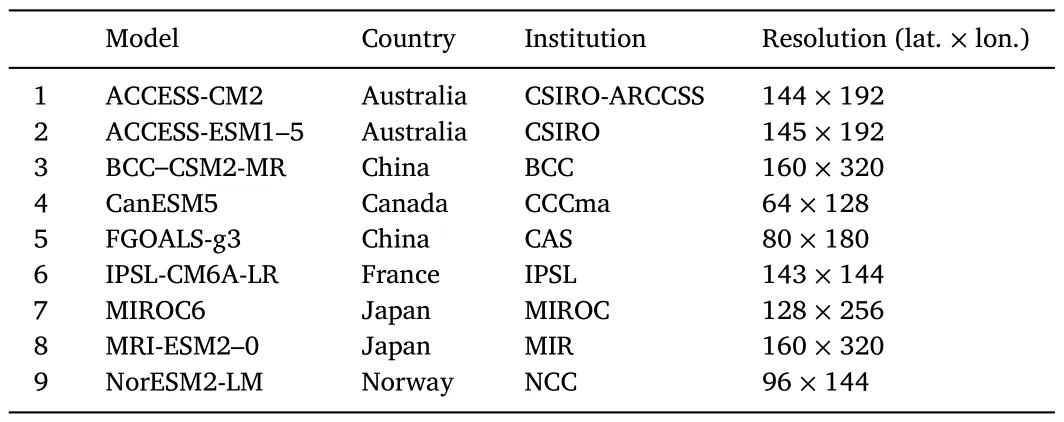
Table 1 Details of the nine CMIP6 models used in this study.

Table 2 Details of the experiments carried out in this study.
To evaluate the performance of the nine models in this study,we used monthly precipitation data from the CN05.1 dataset (Wu and Gao,2013) and CRU TS 4.06 dataset (Harris et al.,2020),and atmospheric circulation data including monthly horizontal winds,sea level pressure(SLP),surface pressure,and specific humidity from the fifth major global reanalysis produced by ECMWF,called ERA5(Hersbach et al.,2020).
In this study,we conducted a statistical analysis of the linear trends during summer (June—July—August) and used the multimodel ensemble(MME)mean method.Before computing the averages over the nine models,we first computed the averages over the number of realizations available for each model.Our study regions are located over the Qinghai—Tibet Plateau and Southwest China.
3.Results
Firstly,we conducted a comparison between model results and observations to evaluate the climatology and linear trends of summer precipitation across the Qinghai—Tibet Plateau and Southwest China during the period 1961—2014.This comparison allowed us to assess the performance of the models in replicating the observed changes in precipitation.
The Qinghai—Tibet Plateau and Southwest China experience complex patterns of summer precipitation due to their varied topography and location within the East Asian monsoon region.As shown in Fig.1,the eastern and southeastern regions of the Qinghai—Tibet Plateau receive more precipitation than the western and northern regions.Generally,the southeastern part of the plateau receives the most precipitation,with an average of around 853.8 mm per summer,while the northwestern part of the plateau receives the least precipitation,with an average of around 15.4 mm per summer,based on the CN05.1 monthly data.The CRU TS 4.06 dataset shows similar results.The distribution of summer precipitation in Southwest China is affected by multiple factors,such as topography,latitude,and the East Asian monsoon.In general,the amount of summer precipitation is higher in regions other than the Qinghai—Tibet Plateau.Specifically,the Sichuan Basin,situated in the central part of Southwest China,receives a larger amount of summer precipitation,whereas the Qinghai—Tibet Plateau to the west and the Yunnan—Guizhou Plateau to the south receive relatively less precipitation.
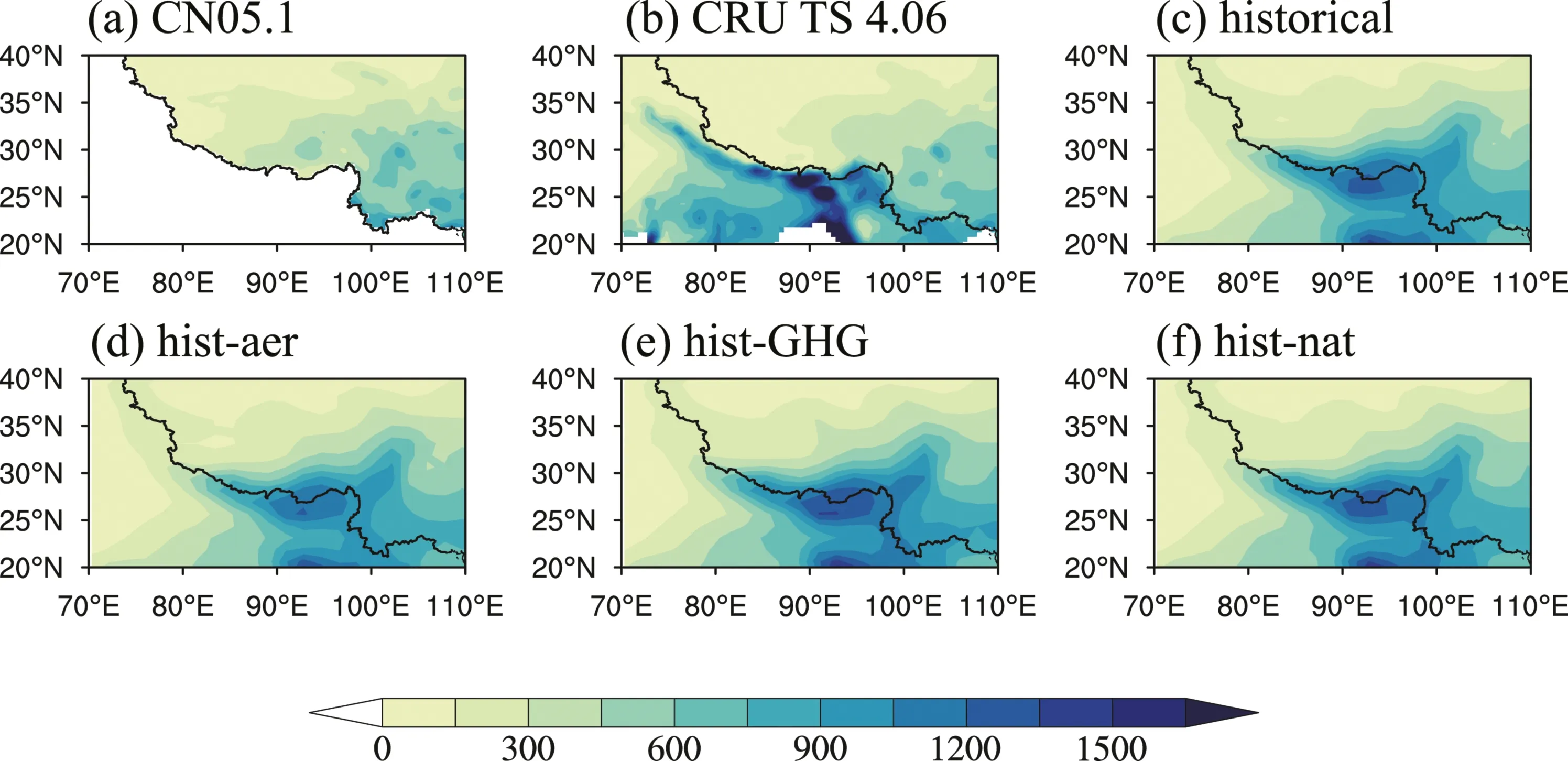
Fig.1.Observed and simulated climatological summer precipitation (units: mm) during 1961—2014: (a) CN05.1;(b) CRU TS 4.06;(c) historical;(d) hist-aer;(e)hist-GHG;(f)hist-nat.
The results of the historical simulation in the CMIP6 MME show a skilled reproduction of the observed distribution characteristics of summer precipitation (Fig.1).However,the CMIP6 MME shows an overestimation of summer precipitation in the study region,particularly in Southwest China and the eastern Himalaya.This bias towards an overestimation of precipitation is also seen in the other experiments.
Fig.2 depicts the linear trends of summer precipitation from 1961 to 2014.The observations reveal a negative trend in summer precipitation over Southwest China,while a positive trend is evident over the Qinghai—Tibet Plateau.This suggests that summer precipitation has increased over the Qinghai—Tibet Plateau but decreased over Southwest China during the past 50 years.The precipitation trends,which align with the observations,are more widespread in the historical ensemble (Fig.2).Notably,the hist-aer MME shows significant negative trends over Southwest China,similar to the observations and the historical MME.In contrast,the hist-GHG MME simulates positive trends in summer precipitation over the Qinghai—Tibet Plateau.In conclusion,greenhouse gasses contribute significantly to the increase in summer precipitation over the Qinghai—Tibet Plateau,while aerosols are primarily responsible for the decrease in summer precipitation over Southwest China.Also,as can be seen from Fig.2(f),the natural external forcing factors do not have a significant effect on the summer precipitation trends in the study area.The findings indicate that different external forces have varying impacts on summer precipitation in different regions of China,leading to spatial variations in precipitation trends.Changes in greenhouse gas concentrations and anthropogenic aerosol emissions play a more important role.
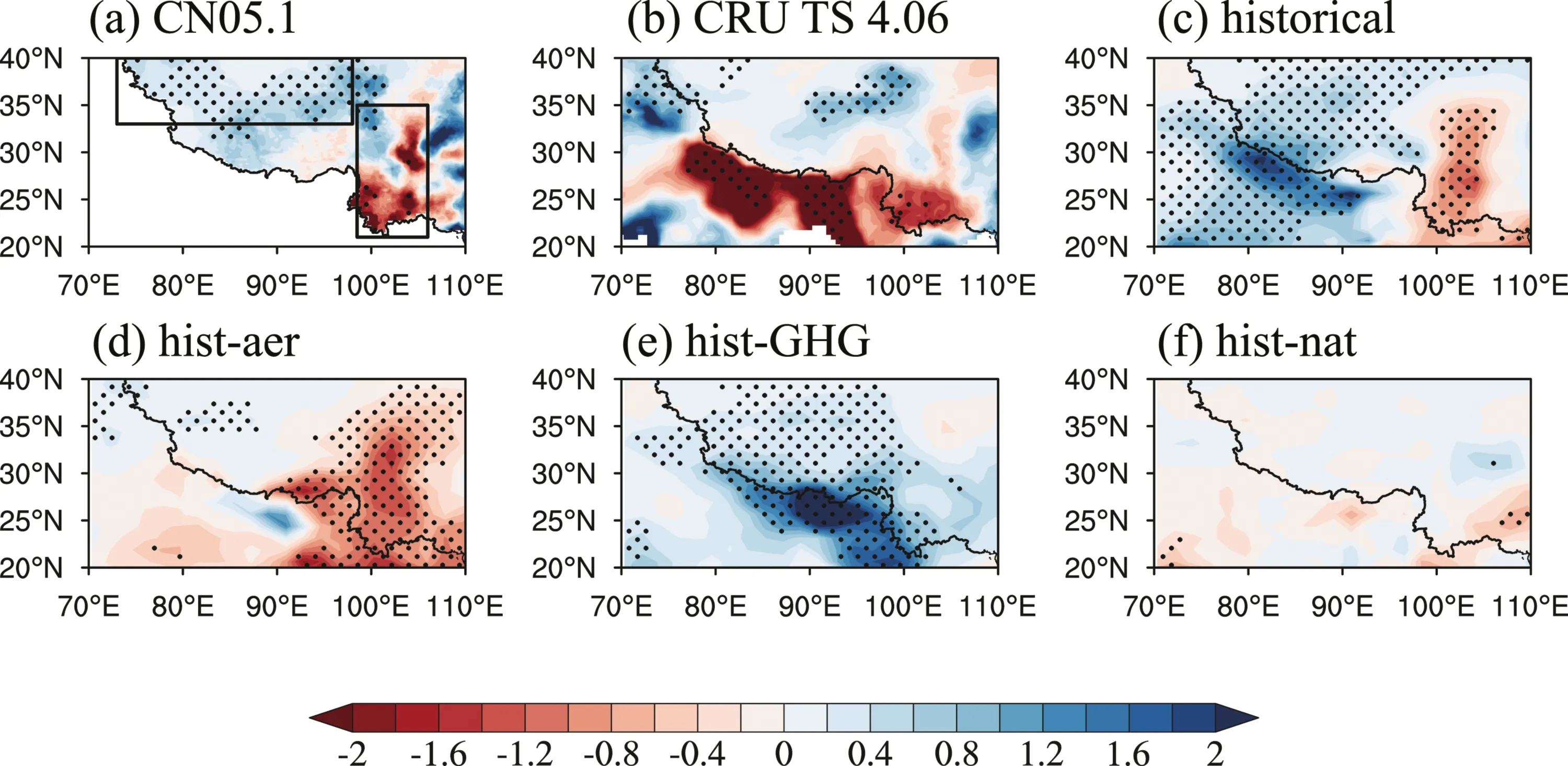
Fig.2.Observed and simulated linear trend of summer precipitation (units: mm yr-1) during 1961—2014: (a) CN05.1;(b) CRU TS 4.06;(c) historical;(d) hist-aer;(e)hist-GHG;(f)hist-nat.Areas with statistical significance exceeding the 95%confidence level are dotted.
As depicted in Fig.3,the trend in regional average summer precipitation can more clearly illustrate the contributions of different external forcing factors.For instance,over the Qinghai—Tibet Plateau(33°—40°N,73°—98°E;Fig.2(a)),the observed trend of increasing summer precipitation can reach up to 0.24 mm yr-1(Fig.3(a)).All the MMEs in the simulation can replicate the positive trend of summer precipitation over the Qinghai—Tibet Plateau.However,after considering all the external forcing factors,the historical MME simulates a larger trend(0.34 mm yr-1)compared to the observation.On the other hand,the hist-GHG MME simulates a summer precipitation trend that is more consistent with the observation.The hist-aer and hist-nat MMEs also simulate an increasing trend in summer precipitation,but it is relatively small,particularly for the hist-nat MME.Therefore,it suggests that the rise in greenhouse gas concentrations is the primary external forcing factor leading to the long-term increase in summer precipitation over the Qinghai—Tibet Plateau.Although anthropogenic aerosol emissions also contribute to the increase in summer precipitation over the Qinghai—Tibet Plateau,the contribution from natural external forcing is insignificant.This conclusion can also be deduced from the spatial variation in summer precipitation trends over the plateau(Fig.2).
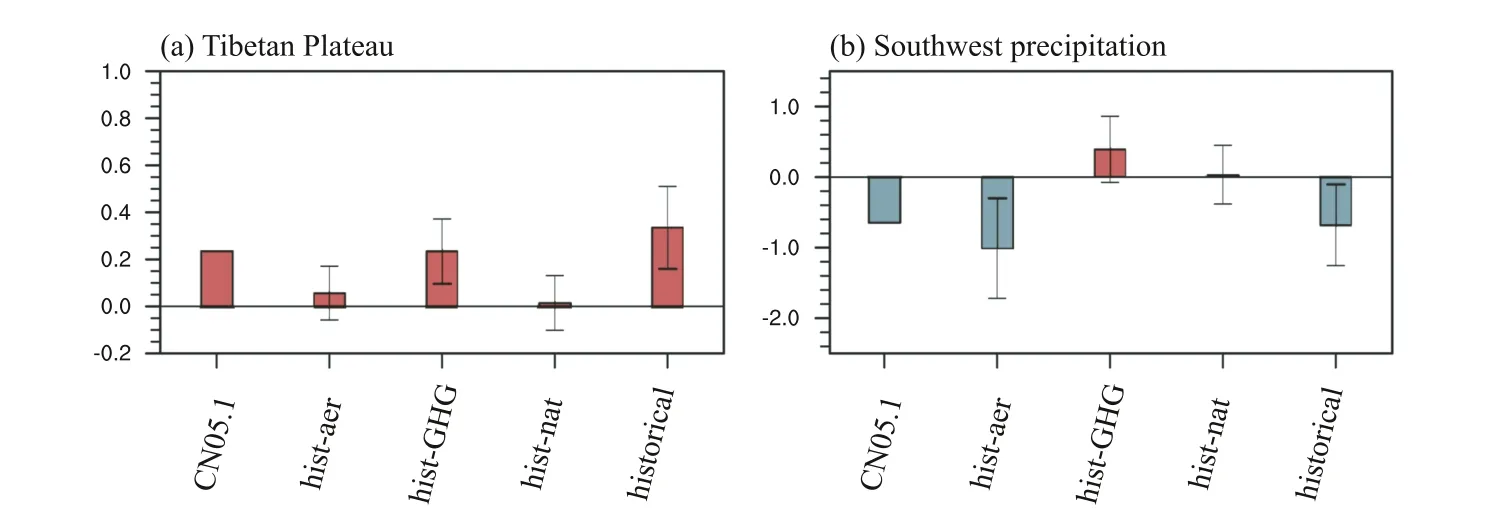
Fig.3.Observed (CN05.1) and simulated linear trends in regionally averaged summer precipitation (units: mm yr-1) during the period 1961—2014 over (a) the Qinghai—Tibet Plateau and(b)Southwest China.The error bars represent the standard deviation of intermodel variability.
For Southwest China (21°—35°N,98.5°—106°E;Fig.2(a)),summer precipitation has shown a decreasing trend over the past 50 years,which is the opposite of the changes seen over the Qinghai—Tibet Plateau.As seen from both the spatial and regional mean results,the historical MME can also simulate well the decreasing trend in summer precipitation over Southwest China (Fig.2 and Fig.3(b)),and the simulated decreasing trend in regional mean precipitation is comparable to the observed values.Comparing the results of other single-forcing experiments,it can be observed that the decrease in summer precipitation over Southwest China is primarily caused by anthropogenic aerosol emission factors.In contrast,the increase in greenhouse gas concentrations has the opposite contribution,partially offsetting the effect of anthropogenic aerosol emissions.Similarly,natural external forcing factors have very little effect on the long-term trends of summer precipitation in Southwest China.
The changes in summer precipitation over Southwest China and the Qinghai—Tibet Plateau are directly attributable to the large-scale circulation and the associated changes in water vapor transport (Liu et al.,2017;Tang et al.,2017).Fig.4 shows the trends in summer SLP and 850-hPa horizontal winds.The historical MME simulates a positive trend in summer SLP over South Asia and the Indochina Peninsula,which is consistent with the observations (Fig.4(a,b)).Therefore,the observed and historical MME—simulated southwest monsoon are weakened.In the hist-nat MME,the weaker characteristics of the southwestern monsoon are more prominent.On the contrary,the hist-GHG MME simulates a strengthened southwest monsoon over the Indochina Peninsula.
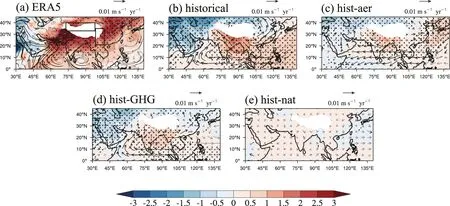
Fig.4.Observed and simulated linear trend in summer SLP (shading;units: Pa yr-1) and 850-hPa wind fields (vectors;units: 0.01 m s-1 yr-1) during 1961—2014:(a)ERA5;(b)historical;(c)hist-aer;(d)hist-GHG;(e)hist-nat.Areas with statistical significance exceeding the 95%confidence level are denoted with dots and black vectors.
Fig.5 shows the trend in water vapor transport caused by the Asian large-scale circulation over the past 50 years.The vectors in both figures are identical,and the shading in the figures represents the changes in water vapor transport flux and divergence of water vapor flux,respectively.During the period 1961—2014,the observed transport of water vapor due to monsoon circulation in Southwest China exhibits a declining trend,while the anomalous southerly and easterly winds lead to an increasing trend in water vapor transport over the Qinghai—Tibet Plateau (Fig.4).Additionally,water vapor transport in Southwest China has displayed an anomalous divergence trend,while most of the water vapor transport over the Qinghai—Tibet Plateau demonstrates an anomalous convergence trend (Fig.5).As a result,summer precipitation over Southwest China has generally decreased,while summer precipitation over the Qinghai—Tibet Plateau has significantly increased.
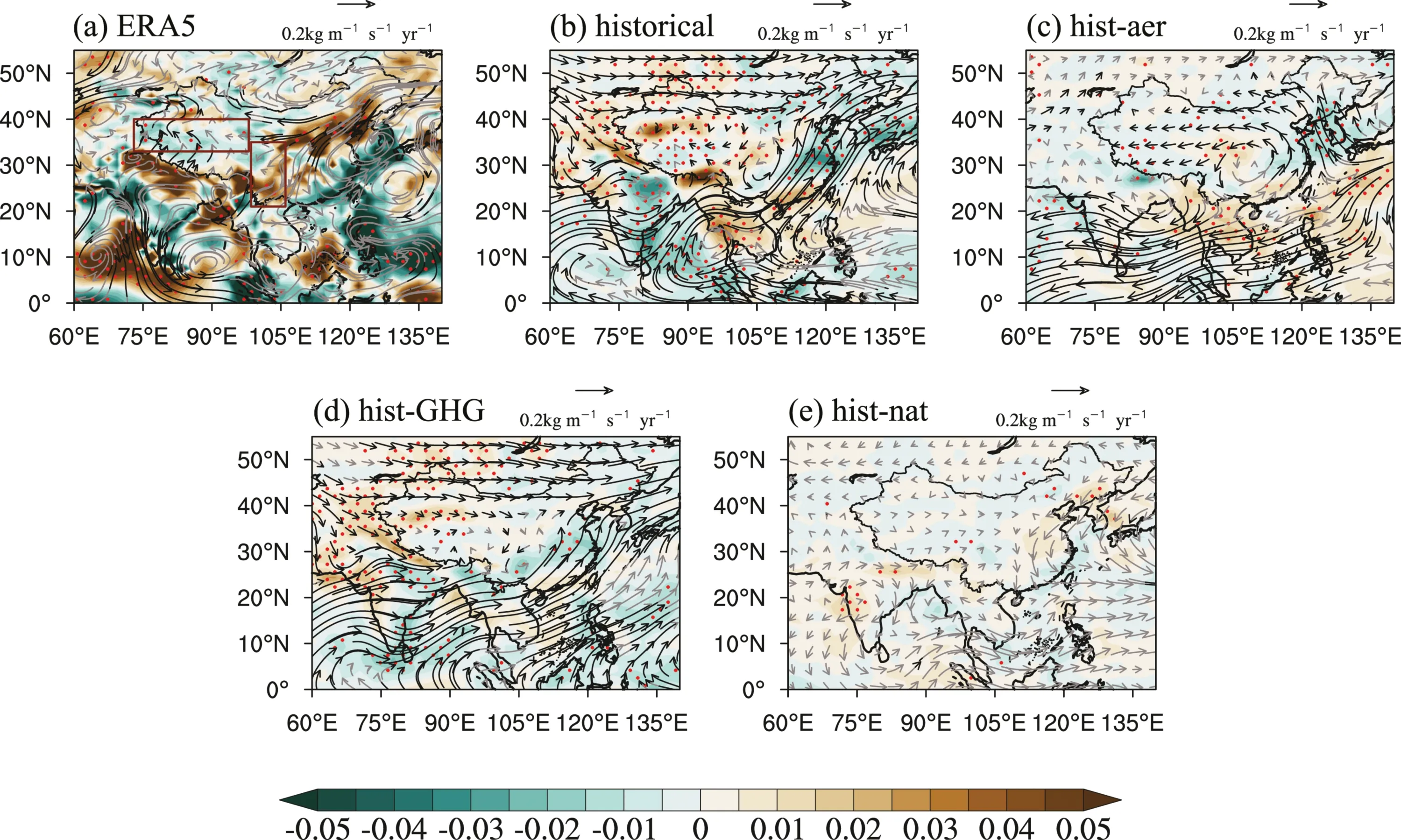
Fig.5.Observed and simulated linear trend in vertically integrated water vapor flux(vectors;units:0.2 kg m-1 s-1 yr-1)and its corresponding divergence(shading;units: 10-5 kg m-2 s-1 yr-1) during 1961—2014: (a) ERA5;(b) historical;(c) hist-aer;(d) hist-GHG;(e) hist-nat.Dotted areas and black vectors are statistically significant above the 95%confidence level.
In the simulation,anthropogenic aerosol emissions are the main external forcing factor leading to a reduction in southwest monsoon circulation,and thus there is weakened water vapor transport and an anomalous divergence trend in Southwest China.This reduction leads to a decreasing trend in summer precipitation in the region.In contrast,the increase in greenhouse gas concentrations leads to global-scale warming,resulting in an increase in the atmospheric water vapor content.When combined with corresponding changes in the local circulation of the Tibetan Plateau in the context of global warming,greenhouse gas forcing factors lead to a significant increase in water vapor transport and a convergence trend,resulting in an increasing trend in summer precipitation over the Qinghai—Tibet Plateau.In the hist-nat MME(Fig.5(e)),the linear trends are not significant,suggesting that natural external forcing factors have little effect on monsoon circulation and related summer precipitation in the two regions.
4.Conclusion
This study investigated the impact of external forcing on summer precipitation trends over the Qinghai—Tibet Plateau and Southwest China from 1961 to 2014 using the latest CMIP6 data.In terms of climatological averages,the southwestern region of China receives more monsoon precipitation during the summer,while summer rainfall gradually decreases towards the west over the Qinghai—Tibet Plateau.Observational data show that summer precipitation increased over the Qinghai—Tibet Plateau but decreased over Southwest China during the period 1961—2014.The CMIP6 historical MME can reproduce these differing precipitation trends in the two regions accurately.
Further comparisons of separate forcing MMEs and observations indicate that greenhouse gasses play a significant role in increasing summer water vapor transport and enhancing water vapor convergence over the Qinghai—Tibet Plateau.Therefore,there is a significant increasing trend in summer precipitation over this region.On the contrary,the increasing anthropogenic aerosol emissions have raised the SLP over South Asia and the Indochina Peninsula,leading to a weakening of the southwestern monsoon circulation and a decreasing trend in summer precipitation over Southwest China.
The processes and mechanisms underpinning the impacts of external forcing factors such as greenhouse gasses and anthropogenic aerosol emissions on the East Asian climate system are highly complex.In this study,we only examined the responses of the summer monsoon circulation and summer precipitation over the Qinghai—Tibet Plateau and Southwest China to external forcing changes by comparing the results of different CMIP6 experiments.The specific physical processes and mechanisms still require more detailed diagnostic analysis and systematic research,which will be addressed in future work.
Funding
This research was supported by the National Key Research and Development Program of China [grant number 2018YFA0606403],the Strategic Priority Research Program of the Chinese Academy of Sciences[grant number XDA23090102],and the National Natural Science Foundation of China[grant number 41822502].
Acknowledgments
The authors thank the two anonymous reviewers and editor for their valuable comments and suggestions,which helped to improve the quality of this paper significantly.
杂志排行
Atmospheric and Oceanic Science Letters的其它文章
- Skill improvement of the yearly updated reforecasts in ECMWF S2S prediction from 2016 to 2022
- Research progress on inter-monthly winter temperature variation in East Asia and climate prediction
- Precursory atmospheric teleconnection patterns for strong Siberian High events
- Distinct impacts of two kinds of El Niño on precipitation over the Antarctic Peninsula and West Antarctica in austral spring
- Impact of the Asian—Pacific Oscillation on early autumn precipitation over Southeast China:CMIP6 evaluation and projection
- More extreme-heat occurrences related to humidity in China
